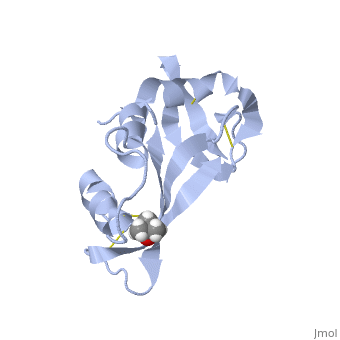Sandbox Reserved 195
From Proteopedia
| This Sandbox is Reserved from Feb 02, 2011, through Jul 31, 2011 for use by the Biochemistry II class at the Butler University at Indianapolis, IN USA taught by R. Jeremy Johnson. This reservation includes Sandbox Reserved 191 through Sandbox Reserved 200. |
To get started:
More help: Help:Editing |
Ribonuclease S
Ribonuclease S consists of two fragments of bovine Ribonuclease A, S peptide and S protein which make up the peptide-protein complex. RNase S has been studied to reveal mechanisms of protein folding by coupling folding and association. Studies of RNase S lead to greater interest in the investigation of RNase A and its role in biological systems. Through such studies, it has been suggested that RNase A and its oligomers could have anti-cancer effects, and a greater knowledge of the correlation between protein folding and enzyme activity.
|
RNase S is RNase A treated with subtilisin, which cleaves a single peptide bond. Consequently, RNase A and RNase S have very similar structures except for a few key areas, one being the cleavage site (residues 16-23) [1]. This contributes to a decrease in order in RNase S. The on RNase A is located between residues Ala 20 and Ser 21. Upon cleavage the fragments S peptide and S protein are identified giving RNase S its structure. consists of residues 1-20, and is largely responsible for proper folding. S protein is comprised of residues 21-124. Additionally, RNase A and RNase S have many conserved sequences. Glutamine 60 is not only conserved in and , but for the entire class of ribonucleases. Glu 60 is also interesting, because it is the only residue in an unfavorable position (Φ= -100, ψ= -130) as defined in the Ramachandran plot [2].
The of RNase S consists of residues His 12, Lys 41, Val 43, Asn 44, Thr 45, His 119, Phe 120, Asp 121, and Ser 123. Residues 1, 15-20, 21-23, and 124 could be removed without serious consequence to the structure or activity of RNase S. Residue 124 could also be removed from RNase A without compromising the structure. [3]
|
Hydrogen bonding and hydrophobic interactions play a major role in the structure of RNase S. [4]

